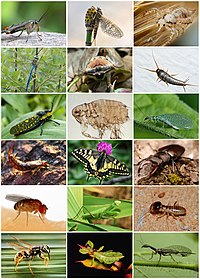
Decline of insects and arachnids driven by nutrient enrichment: A meta‐analysis
Sign Up to like & getrecommendations! Published in 2022 at "Ecology"
DOI: 10.1002/ecy.3897
Abstract: Abstract Recent studies have documented global declines in insects and their relatives, but the exact mechanisms explaining these patterns are not fully understood. A potential driver underlying arthropod population declines is increases in anthropogenic inputs… read more here.
Keywords: insects; arachnids; decline insects; insects arachnids ... See more keywords

The Impact of Whole Genome Duplication on The Evolution of The Arachnids.
Sign Up to like & getrecommendations! Published in 2023 at "Integrative and comparative biology"
DOI: 10.1093/icb/icad050
Abstract: The proliferation of genomic resources for Chelicerata in the past ten years has revealed that the evolution of chelicerate genomes is more dynamic than previously thought, with multiple waves of ancient whole genome duplications affecting… read more here.
Keywords: genome duplication; arachnids; whole genome; duplication ... See more keywords

High phylogenetic utility of an ultraconserved element probe set designed for Arachnida
Sign Up to like & getrecommendations! Published in 2017 at "Molecular Ecology Resources"
DOI: 10.1111/1755-0998.12621
Abstract: Arachnida is an ancient, diverse and ecologically important animal group that contains a number of species of interest for medical, agricultural and engineering applications. Despite their importance, many aspects of the arachnid tree of life… read more here.
Keywords: high phylogenetic; arachnids; utility; arachnid tree ... See more keywords

Ecology of female mating failure/lifelong virginity: a review of causal mechanisms in insects and arachnids
Sign Up to like & getrecommendations! Published in 2019 at "Entomologia Experimentalis et Applicata"
DOI: 10.1111/eea.12759
Abstract: Sexual reproduction implies binary outcomes of competitive interactions for access to male gametes: lifelong virgin females with null fitness vs. mated females with variable (generally nonzero) fitness. Female mating failure has long remained a dormant… read more here.
Keywords: insects; lifelong virginity; arachnids; female mating ... See more keywords

Proteonematalycus wagneri Kethley reveals where the opisthosoma begins in acariform mites
Sign Up to like & getrecommendations! Published in 2022 at "PLoS ONE"
DOI: 10.1371/journal.pone.0264358
Abstract: It is generally thought that the anterior border of the opisthosoma of acariform mites is delineated by the disjugal furrow, but there is no evidence to support this other than the superficial appearance of tagmosis… read more here.
Keywords: acariform mites; proteonematalycus wagneri; disjugal furrow; arachnids ... See more keywords

Tick Paralysis: Solving an Enigma
Sign Up to like & getrecommendations! Published in 2018 at "Veterinary Sciences"
DOI: 10.3390/vetsci5020053
Abstract: In comparison to other arachnids, ticks are major vectors of disease, but less than 8% of the known species are capable of inducing paralysis, as compared to the ~99–100% arachnids that belong to venomous classes.… read more here.
Keywords: arachnids; solving enigma; tick paralysis; paralysis ... See more keywords